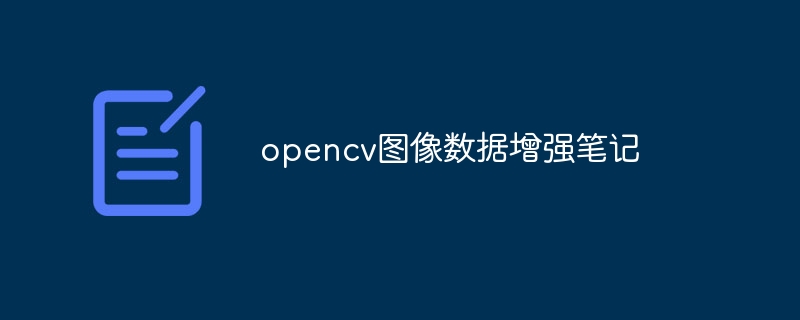本文是使用OpenCV实现各类图像增广的笔记,介绍了图片放缩、二值化与阈值处理(含大津法)、翻转(含随机翻转)、去噪声、腐蚀膨胀、旋转、亮度调节、随机裁剪等14种图像增广方法,每种方法均给出了相应的实现代码及效果展示。
☞☞☞AI 智能聊天, 问答助手, AI 智能搜索, 免费无限量使用 DeepSeek R1 模型☜☜☜

图像增广方法有很多,此项目做了如下几个例子的展示(后续再有所其它应用会更新,如果各位有其它需求欢迎评论区催更)
- 图片放缩
- 图片二值化,阈值处理(大津法求最优阀值)
- 图片翻转
- 图片去噪声
- 图片的腐蚀膨胀
- 图片旋转
- 图片亮度调节
- 图片随机裁剪
- 图片随机添加蒙版
- 图片边缘填充
- 修改图片饱和度
- 图片放大、平移
- x轴的剪切变换,角度15°
定义函数类结构如下:
class FunctionClass:
def __init__(self, parameter): self.parameter=parameter def __call__(self, img):# 导入相关包import cv2import numpy as npfrom matplotlib import pyplot as plt %matplotlib inline
filename = 'lena.jpg'img = cv2.imread(filename) img = cv2.cvtColor(img, cv2.COLOR_BGR2RGB)print(img.shape) # 输出通道数,大小是350*350 3通道plt.imshow(img)
(350, 350, 3)
<matplotlib.image.AxesImage at 0x7f0cdc371310>
<Figure size 432x288 with 1 Axes>
class Resize:
def __init__(self, size):
self.size=size def __call__(self, img):
return cv2.resize(img, self.size)# Resize( (600, 600))通过修改函数中参数进行调节图片的大小resize=Resize( (600, 600))
img_resize=resize(img)
plt.imshow(img_resize)<matplotlib.image.AxesImage at 0x7f6a7c06ed90>
<Figure size 432x288 with 1 Axes>
#载入原图img_original=cv2.imread('lena.jpg',0)#迭代阈值分割print("请输入阈值0-255")
thresh = int(input())
retval,img_global=cv2.threshold(img_original,thresh,255,cv2.THRESH_BINARY)print(retval)
#最优阈值ret2,th2 = cv2.threshold(img_original,0,255,cv2.THRESH_OTSU)print(ret2)#显示图片plt.subplot(1,3,1)
plt.imshow(img_original,'gray')
plt.title('Original Image')
plt.subplot(1,3,2)
plt.hist(img_original.ravel(),256)#.ravel方法将矩阵转化为一维plt.subplot(1,3,3)
plt.imshow(th2,'gray')
plt.title('Otsu thresholding')
plt.show()请输入阈值0-255
111.0 116.0
<Figure size 432x288 with 3 Axes>
class Flip:
def __init__(self, mode):
self.mode=mode def __call__(self, img):
return cv2.flip(img, self.mode)# 指定翻转类型(非随机)# mode=0垂直翻转、1水平翻转、-1水平加垂直翻转flip=Flip(mode=0)
img_flip=flip(img)
plt.imshow(img_flip)<matplotlib.image.AxesImage at 0x7f6a5c32e650>
<Figure size 432x288 with 1 Axes>
import random# 随机翻转class RandomFlip((object)):
def __init__(self, mode=1):
# 设置一个翻转参数,1、0或-1,默认1
assert mode in [-1, 0, 1], "mode should be a value in [-1, 0, 1]"
self.mode = mode def __call__(self, img):
# 随机生成0或1(即是否翻转)
if random.randint(0, 1) == 1: return cv2.flip(img, self.mode) else: return imgrandomflip=RandomFlip(0) img_randomflip=randomflip(img) plt.imshow(img_randomflip)
<matplotlib.image.AxesImage at 0x7f6a14269990>
<Figure size 432x288 with 1 Axes>
def gasuss_noise(image, mean=0, var=0.001): # 模拟高斯噪声
'''
添加高斯噪声
mean : 均值
var : 方差
'''
image = np.array(image/255, dtype=float)
noise = np.random.normal(mean, var ** 0.5, image.shape)
out = image + noise if out.min() < 0:
low_clip = -1.
else:
low_clip = 0.
out = np.clip(out, low_clip, 1.0)
out = np.uint8(out*255) return outimg_noise = gasuss_noise(img) # 添加噪声dst = cv2.fastNlMeansDenoisingColored(img,None,10,10,7,21) # 去噪函数plt.subplot(121),plt.imshow(img_noise) # 含噪声(绿点)图plt.subplot(122),plt.imshow(dst) # 去噪后的图plt.show()
<Figure size 432x288 with 2 Axes>
kernel = np.ones((3, 3), dtype=np.uint8) # 定义3x3卷积核dilate = cv2.dilate(img, kernel, 1) # 1:迭代次数,也就是执行几次膨胀操作erosion = cv2.erode(img, kernel, 1) plt.subplot(131),plt.imshow(img) plt.subplot(132),plt.imshow(dilate) # 膨胀plt.subplot(133),plt.imshow(erosion) # 腐蚀plt.show()
<Figure size 432x288 with 3 Axes>
class Rotate:
def __init__(self, degree,size):
self.degree=degree
self.size=size def __call__(self, img):
h, w = img.shape[:2]
center = (w // 2, h // 2) # 采取中心点为轴进行旋转
M = cv2.getRotationMatrix2D(center,self.degree, self.size) return cv2.warpAffine(img, M, (w, h))# 参数1是旋转角度,参数2是图像比例rotate=Rotate(45, 0.7)
img_rotating=rotate(img)
plt.imshow(img_rotating)<matplotlib.image.AxesImage at 0x7f0cdc358990>
<Figure size 432x288 with 1 Axes>
class Brightness:
def __init__(self,brightness_factor):
self.brightness_factor=brightness_factor def __call__(self, img):
img_hsv = cv2.cvtColor(img, cv2.COLOR_BGR2HSV) # 通过cv2.cvtColor把图像从BGR转换到HSV
darker_hsv = img_hsv.copy()
darker_hsv[:, :, 2] = self.brightness_factor * darker_hsv[:, :, 2] return cv2.cvtColor(darker_hsv, cv2.COLOR_HSV2BGR)
brightness=Brightness(0.6)
img2=brightness(img)
plt.imshow(img2)<matplotlib.image.AxesImage at 0x7f0cdc2c2610>
<Figure size 432x288 with 1 Axes>
import randomimport mathclass RandCropImage(object):
""" random crop image """
""" 随机裁剪图片 """
def __init__(self, size, scale=None, ratio=None, interpolation=-1):
self.interpolation = interpolation if interpolation >= 0 else None
if type(size) is int:
self.size = (size, size) # (h, w)
else:
self.size = size
self.scale = [0.08, 1.0] if scale is None else scale
self.ratio = [3. / 4., 4. / 3.] if ratio is None else ratio def __call__(self, img):
size = self.size
scale = self.scale
ratio = self.ratio
aspect_ratio = math.sqrt(random.uniform(*ratio))
w = 1. * aspect_ratio
h = 1. / aspect_ratio
img_h, img_w = img.shape[:2]
bound = min((float(img_w) / img_h) / (w**2),
(float(img_h) / img_w) / (h**2))
scale_max = min(scale[1], bound)
scale_min = min(scale[0], bound)
target_area = img_w * img_h * random.uniform(scale_min, scale_max)
target_size = math.sqrt(target_area)
w = int(target_size * w)
h = int(target_size * h)
i = random.randint(0, img_w - w)
j = random.randint(0, img_h - h)
img = img[j:j + h, i:i + w, :] if self.interpolation is None: return cv2.resize(img, size) else: return cv2.resize(img, size, interpolation=self.interpolation)crop = RandCropImage(350) plt.imshow(crop(img))
<matplotlib.image.AxesImage at 0x7f559c786150>
<Figure size 432x288 with 1 Axes>
# 随机裁剪图片class RandomErasing(object):
def __init__(self, EPSILON=0.5, sl=0.02, sh=0.4, r1=0.3,
mean=[0., 0., 0.]):
self.EPSILON = EPSILON
self.mean = mean
self.sl = sl
self.sh = sh
self.r1 = r1 def __call__(self, img):
if random.uniform(0, 1) > self.EPSILON: return img for attempt in range(100):
area = img.shape[0] * img.shape[1]
target_area = random.uniform(self.sl, self.sh) * area
aspect_ratio = random.uniform(self.r1, 1 / self.r1)
h = int(round(math.sqrt(target_area * aspect_ratio)))
w = int(round(math.sqrt(target_area / aspect_ratio))) #print(w)
# 此处插入代码
if w < img.shape[0] and h < img.shape[1]:
x1 = random.randint(0, img.shape[1] - h)
y1 = random.randint(0, img.shape[0] - w) if img.shape[2] == 3:
img[ x1:x1 + h, y1:y1 + w, 0] = self.mean[0]
img[ x1:x1 + h, y1:y1 + w, 1] = self.mean[1]
img[ x1:x1 + h, y1:y1 + w, 2] = self.mean[2] else:
img[x1:x1 + h, y1:y1 + w,0] = self.mean[0] return img
return img
erase = RandomErasing()
img2=erase(img)
plt.imshow(img2)<matplotlib.image.AxesImage at 0x7f559c777ed0>
<Figure size 432x288 with 1 Axes>
# 图片边缘填充class Pooling:
def __init__(self,pooling1,pooling2,pooling3,pooling4):
self.pooling1=pooling1
self.pooling2=pooling2
self.pooling3=pooling3
self.pooling4=pooling4 def __call__(self, img):
# 全0填充,若填充其它颜色,需修改下面value中数值即可
img_pool = cv2.copyMakeBorder(img, self.pooling1, self.pooling2, self.pooling3, self.pooling4,
cv2.BORDER_CONSTANT,
value=(0, 0, 0)) return img_pool
# Pooling()中的4个参数分别是,上下左右填充的像素大小pooling=Pooling(10,20,30,40)
img2=pooling(img)
plt.imshow(img2)<matplotlib.image.AxesImage at 0x7f0cdc290310>
<Figure size 432x288 with 1 Axes>
# 修改图片饱和度class Saturation:
def __init__(self,saturation_factor):
self.saturation_factor=saturation_factor def __call__(self, img):
img_hsv = cv2.cvtColor(img, cv2.COLOR_BGR2HSV) # 通过cv2.cvtColor把图像从BGR转换到HSV
colorless_hsv = img_hsv.copy()
colorless_hsv[:, :, 1] = self.saturation_factor * colorless_hsv[:, :, 1] return cv2.cvtColor(colorless_hsv, cv2.COLOR_HSV2BGR)
saturation=Saturation(0.6)
img2=saturation(img)
plt.imshow(img2)<matplotlib.image.AxesImage at 0x7f0cdc170ed0>
<Figure size 432x288 with 1 Axes>
# 放大+平移class AmplificationTranslation:
def __init__(self,mode1,mode2,mode3):
self.mode1=mode1
self.mode2=mode2
self.mode3=mode3 def __call__(self, img):
M_crop = np.array([
[self.mode1, 0, self.mode2],
[0, self.mode1, self.mode3]
], dtype=np.float32)
img = cv2.warpAffine(img, M_crop, (img.shape[0], img.shape[1])) return img# 将彩色图的BGR通道顺序转成RGBimg = cv2.cvtColor(img, cv2.COLOR_BGR2RGB)
# AmplificationTranslation()中,参数分别是:放大倍数、平移坐标(-150,-240)ATion=AmplificationTranslation(1.6,-150,-240)
img2=ATion(img)
plt.imshow(img2)<matplotlib.image.AxesImage at 0x7f0cdc0caf10>
<Figure size 432x288 with 1 Axes>
class ShearAngle:
def __init__(self,mode):
self.mode=mode def __call__(self, img):
# x轴的剪切变换,角度15°
theta = self.mode * np.pi / 180
M_shear = np.array([
[1, np.tan(theta), 0],
[0, 1, 0]
], dtype=np.float32)
img_sheared = cv2.warpAffine(img, M_shear, (img.shape[0], img.shape[1])) return img_sheared# 将彩色图的BGR通道顺序转成RGBimg = cv2.cvtColor(img, cv2.COLOR_BGR2RGB)
# ShearAngle()中,参数是:角度SAion=ShearAngle(15)
img2=SAion(img)
plt.imshow(img2)<matplotlib.image.AxesImage at 0x7f559c426250>
<Figure size 432x288 with 1 Axes>
以上就是opencv图像数据增强笔记的详细内容,更多请关注php中文网其它相关文章!

每个人都需要一台速度更快、更稳定的 PC。随着时间的推移,垃圾文件、旧注册表数据和不必要的后台进程会占用资源并降低性能。幸运的是,许多工具可以让 Windows 保持平稳运行。

 C++高性能并发应用_C++如何开发性能关键应用
C++高性能并发应用_C++如何开发性能关键应用
 Java AI集成Deep Java Library_Java怎么集成AI模型部署
Java AI集成Deep Java Library_Java怎么集成AI模型部署
 Golang后端API开发_Golang如何高效开发后端和API
Golang后端API开发_Golang如何高效开发后端和API
 Python异步并发改进_Python异步编程有哪些新改进
Python异步并发改进_Python异步编程有哪些新改进
 C++系统编程内存管理_C++系统编程怎么与Rust竞争内存安全
C++系统编程内存管理_C++系统编程怎么与Rust竞争内存安全
 Java GraalVM原生镜像构建_Java怎么用GraalVM构建高效原生镜像
Java GraalVM原生镜像构建_Java怎么用GraalVM构建高效原生镜像
 Python FastAPI异步API开发_Python怎么用FastAPI构建异步API
Python FastAPI异步API开发_Python怎么用FastAPI构建异步API
 C++现代C++20/23/26特性_现代C++有哪些新标准特性如modules和coroutines
C++现代C++20/23/26特性_现代C++有哪些新标准特性如modules和coroutines
Copyright 2014-2025 https://www.php.cn/ All Rights Reserved | php.cn | 湘ICP备2023035733号